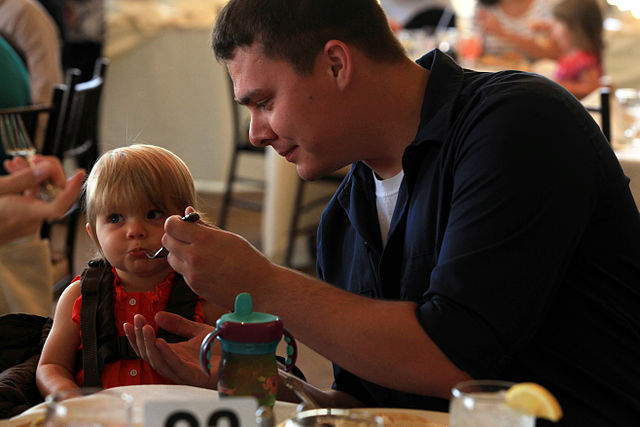
A couple of weeks ago I contributed to a magazine article about stay at home dads (SAHDs). I felt it was a good piece, relying heavily on the first-hand accounts of four guys who, like me, look after the children and run the household.
The article also made a bold claim about the number of SAHDs in the UK. It said official figures revealed a steep rise in the number of SAHDs and that there are now 250,000 of us in the UK. I am familair with this claim. Give or take 10,000, it’s one that is occasionally repeated in the media.
Unlike the magazine I spoke to, it is usually an article in the excitable right-leaning press. It’ll be based on a biased interpretation of the statistics and bemoan the falling number of stay at home mums while also flagellating any woman who has the audacity to combine work and children (you know, as women have been doing since the dawn of time).
That aside, the figure of 250,000, causes me to wince. Why so? Well, it does not relate to the number of stay at home dads. That figure relates to the number of men who are economically inactive because they look after family and home.
A reasonable proprotion of these guys will be looking after children. Even so, the figure will be inflated by men looking after an ill spouse, elderly relative or fulfilling some other caring role.
I thought I’d set myself a challenge. Could I find out how many SAHDs there are in the UK? I’ve long heard it said there’s a huge statistical black hole in this area but felt it would be fun to give it a shot anyway.
To achieve this, I consulted with the Office of National Statistics (ONS), fatherhood research charity The Fatherhood Institute and, to get an idea what employment trends for men are like, the Confederation of British Industry (CBI).
What I discovered amazed me. There is indeed a huge statistical black hole. What I hadn’t appreciated was how large it is.
What we know for sure. . .
The ONS collates and publishes a variety of data quarterly. Last week it published a new set of data under the heading: Economic inactivity by reason: looking after family and home.
For men aged 16-64 the figure between March and May 2015 was 246,000. For women, the figure was 2,020,000.
The comparable figures for 2013 were as follows: 210,000 men versus 2,904,000.
As you can see, there has been a steep fall in the number of economically inactive women who look after family and home. While the figures for men did fluctuate a bit, the overall trend was an upward swing; more and more men are fulfilling this role.
Considering changing working patterns, how traditional gender roles are breaking down and that women increasingly out-earn men, it is safe to assume that a fair chunk of these men are stay at home dads, although this can’t be guaranteed.

But. . .
The next time you read a news article bemoaning the fall in stay at home mums and rise in stay at home dads, run for the hills. The ONS does not collect or collate data about stay at home parents.
I was very keen to ensure I was getting my facts straight on this point. I asked the boffins at the ONS to proof read the following sentence:
The ONS has been crystal clear with me, it does not collect or classify data relating specifically to stay at home mums or dads.
The one comment the ONS made was that I should add the word “specifically”.
In other words, we don’t know how many stay at home dads exist in the UK. There is also no official figure for the number of stay at home mums (a rare case of equality in parenting??).
My initial reaction to this was; “How ridiculous. The world’s going to the dogs, the ONS should collect that data.”
When I’d calmed down, however, I began to appreciate how phenomenally difficult that would be. Is a work at home parent a stay at home parent? What of divorced parents who successfully share custody 50/50? How do you class step-parents?
In some form or other, it should be possible for the ONS to create a classification (or classifications) for stay at home mums and dads. Even so, I can see that it would be a monumental task fraught with complications.
We now have to look at economic activity. This is where things get really murky.
You may not realise it, but you’re probably a working parent
We’ve established the ONS does not collect figures in relation to stay at home parents. By default, this means there is no official definition for this role.
To appear in the figures outlined above, you must be completely economically inactive.
Perhaps you make a little money blogging? Maybe you have a small cake decorating business? You possibly do a few hours of paid work in a local charity shop on a Saturday, the primary motivation being to socialise with adults and let dad (or maybe even mum) spend some time with the kids? If so, you will appear in a completely different set of data. You may be your kids’ main carer, but you would be classed as economically activeinstead of fulfilling a caring role.
Once again, I asked the ONS boffins to proof read a statement for me:
A mum or dad might do a few hours of paid work in a charity shop on a Saturday. They wouldn’t feature in these figures because they would be considered economically active.
I was informed the above statement was correct.
So what is going on in the world of fatherhood?

There is no concrete data about stay at home dads (or indeed mums). As mentioned above, I also spoke to the Fatherhood Institute. The response from these guys, and they are a magnificent bunch, was to point me in the direction of the ONS plus a plethora of studies about men’s working patterns. I also spoke to a contanct or two in the world of academia. The response can be summarised thus; “Good luck, there’s not much reliable data out there.”
It seems the ONS data is the best we have. On that basis, it should be safe to assume that a fair few of the 246,000 men featuring in the ONS’s statistics are looking after children. As I’ve stated above, there’s no question about it, this figure is rising.
Let us also not forget gay adoption and marriage are a reality. The numbers may be small, but gay couples are raising children and that means an inevitable increase in men fulfilling childcare roles.
In the United States, the Pew Research centre has concluded the number of stay at home fathers has doubled since 1989 and stands at around two million today. Where the US goes, the UK tends to follow.
Let’s return to Blighty and look at other trends. Research partnership Modern Fatherhood has undertaken studies concluding the traditional family set-up with dad as the breadwinner is becoming ever more fluid. Although fathers tend to work slightly longer hours, men are, overall, working fewer hours than has historically been the case. This comes from Modern Fatherhood’s website:
Between 2001 and 2011 the proportion of fathers working 48 or more hours per week has fallen from 40% to 31%, compared with 35% to 29% for all men.
Between 2001 and 2011 the proportion of fathers working 60 or more hours has fallen from 13% to 10%, compared with 11% to 9% for all men.
Here is a brief highlight from the Working Families’ Modern Families Index (published January 2015):
Within couple households, there has been a convergence between parents in the amount of paid work that they do. Fathers are also working less intensively and are more likely to be around in the evenings and at weekends as the number working non-standard hours has fallen.
This is a very long-winded way of saying that men are increasingly available at home and able to get involved in family life. Only a small number may give up careers to look after the kids full-time, but most men are in a position to be more hands on.
The CBI had already spotted this trend. As part of its ongoing Great Business Debate campaign, it has called on employers to do more to offer employees flexible working.
In conclusion
The first point to conclude is that I failed. I did not manage to find a figure from a trusted source about the number of stay at home dads in the UK. That said, all the indications are that it’s a growing population and there’s no reason to assume this trend will change.
The ONS is clearly in an awkward position, but it strikes me research is desperately needed into the number of stay at home dads and mums. Having found out that no official data is held for either group, it begs the question as to what basis the Government makes decisions when providing parent-focused services?
For the prviate sector, all the evidence shows men are becoming more and more involved with their children and family life. Albeit in small numbers, it seems men are increasingly giving up careers to fulfil the main childcare role. Even so, this trend is frequently ignored and parent, child and family products are all too often marketed at mums.
There could also be an absolutely ginormous army of stay at home dads who go completely under the radar. They may be economically inactive, or they may be active, baking the odd cake or blogging for small sums of money. We simply don’t know if they exist. Parental isolation is a serious issue for mums, for all we know there’s a massive population of dads who are desperately isolated (there may not be, but the research hasn’t been done).
Finally, and probably most importantly, just make sure you treat the excitable right-leaning media with the suspicion it deserves.
With thanks to the ONS, Fatherhood Institute, CBI and Dr Esther Dermott for their assistance.
Pic credits:
David Beckham image: rights owned by Adidas, reproduced under Creative Commons agreement. Sourced from Flikr.com.
Stats image: Lendingmemo.com. Sourced from Flikr.com. Reproduced under Creative Commons agreement (link above).
Man and baby: Image taken by US Governemnt employee and image in the public domain.







57 thoughts on “It’s official; stay at home dads do not exist”
I think it shows that both “right” and “left” have little hard data to go on. Policy is frequently made in the face of what data there is. The ONS has every reason to be frustrated as it has admonished ministers for untruths quite often , indeed it wrote formally twice to the Labour government on the issue of “misrepresenting” the stats on the gender pay gap.
A very fair point, both the left and right can mis-interpret data to their own ends and I thank you for commenting.
This is so interesting. I never realised that there was so little concrete data on stay at home parents but agree that this would be very difficult to define. I consider myself to be a full-time stay at home mum but I also work from home part-time (whilst still looking after my children) so would not appear in the figures as I’m not economically inactive. I’m not sure how you would manage to collect data to produce a more accurate reflection of the true numbers of stay at home parents though.
I’m with you Louise. I work from home and fit round the children, school run, activity clubs and all the other elements of family life a stay at home parent has to consider. In truth I suspect the population of economically inactive stay at home parents must be tiny becasue the majority are active to a greater or lesser degree.
Excellent piece, John. The absence of data is an issue as it would provide the basis for lobbying on policy changes where needed. Family details are collected – just today I completed a council questionnaire at a play group – but they’re not necessarily asking the right questions.
Having had members of the family who are carers for elderly parents, the role of care-giver can be overlooked in its many guises. However it’s an area where support could be incredibly helpful. Given the current government’s fixation on economic activity and cutting spending on services, it wouldn’t suprise me if identifying the size of this unrecognised workforce isn’t high on their agenda.
Thanks for your kind words Dan. Yes, I can well imagine Mr Osbourne and his chums tracking down all carers…quite possibly with the intention of getting htem to complete a tax return!
I guess it must be hard for men to switch off from ‘work mode’. They always find a way to make some money. Even if it’s a little. Must be in the alpha male gene.
I’m not sure I’d put it quite like that…but if a man has been raised his whole life expecting to be the breadwinner it would make sense for him to continue earning something if he were a stay at home parent. That said, how many women are carers as defined by the ONS? Mis-classification must be rife as most women undertake some form of economic activity, even if it is just small amounts cash in hand.
Really interesting and kind of scary post in the fact that the stats or just not there but yet the media is reporting these so called numbers! I always assumed more dads were staying at home but yet when I think I don’t know any or rarely see any out and about. It’s definitely something where more work is needed as the resources and the mindset that only mums don’t work and look after kids, needs to change xx #thetruthabout
I’m in agreement as to the situation with the stats but firstly I have to wonder what the government would do with the numbers even if they were a true reflection- they’d find a way to spin things the way that suited their aims and intentions – secondly I’d like to have a more specific understanding of what kind of things you want changed – it’s hard for us mums to get a handle on what it is that’s missing for you as dads although I’m sure that isolation is a big problem with regards baby & toddler groups and stuff like that. I guess the fact that children’s centres do dad- specific groups is progress in the right direction… What kind of product marketing would you like changed? (Sorry if I’m being obtuse!). Thanks for linking up today John – very thought provoking. #thetruthabout
Well, the point of this post wasn’t so much to create a “list of demands for change,” more to highlight that we simply don’t know how many dads are the main carers for their children. Bearing in mind 171,000 single-parent families are headed by men (around 8% of the total number), the numbers are likely to be much higher than the 250K stated by the ONS. I personally think economic activity is a side issue; if you’re the kids’ main carer then this should be aknowledged.
As you’ve asked what should be changed, I can think of many things. It’s no surprise the maternity system is geared up towards women. This is how it should be. But…it does so at the expense of men’s invovlement. Men have only just received the legal right to time off work attend birth scans. This should have been the norm for years. Speak to any man, and I’ll guarantee you he has been ignored by a hospital sonographer (and probably had some dreadful experiences with other health professionals. I could tell you a few stories of things I’ve experienced). I fear sonographers have a very bad reputation for treating men like second class citizens (yup, experienced this too). In isolation, these individual experiences may not sound like simple irritations, but it all stacks up and gives men the message their role is secondary. This is before the child has even been born. This approach may change if healthcare providers appreciated the true involvement of men as parents.
Look around at the way products are marketed to parents. The one example that screams out at me is Mothercare. Not only is the store name outdated, but the company’s corporate website clearly states it exists to support “mums”. Nappies, wipes, shampoos…all those things a father would buy and use. Well, Mothercare’s corproate statement might as well say “dad, you wait outside, mum should do the shoppng.”
So, yeah, I could go on! I’ll leave it there for now. Suffice it so say men face some major issues as fathers and the lack of reliable data about the number of guys who look after their kids and do it well doesn’t help.
Thanks for such an in depth response! I guess this is feminism from a man’s point of view (it should really be called Humanism although I guess that term is already taken) – it’s equality isn’t it and recognition of the fact that different jobs with traditional gender bias should have that bias removed in this day and age. I’d never really thought that much about Mothercare or the attitudes of healthcare professionals to men before – I think my husband has no interest in that sort of thing although he has looked after the children alone one day a week since I went back to work part time and has definitely talked about feeling left out of the mother cliques that tend to form out there.
It is, as you say, feminism for men. There are several different names for it but “masculism” is the most popular. Even so, I stand where you do; no one gender should out-do the other, it’s about equality and in this intsance there should be a recognigion that men are as capable of childcare of women. The recent Sate of the World’s Fathers report invovled the study of data from 30 different countries and concluded that both men and were were as “hardwired” as each other to provide care for kids. Your husband may have no interest in such matters, but by spending one day a week flying solo with the kids he is, in fact, quite a trailblazer!
An excellent and well-researched piece, John. And one that appeals to the stats geek in me!
A couple of things (okay, three) to note about the ONS data.
1. The only ‘accurate’ read we have into population demographics is the national census, which takes place once every ten years. And even that is not 100% accurate – I forget the completion rate but it is gradually falling and is not necessarily demographically representative as certain segments of the population (e.g. those for whom English is not their first language) are far less likely to fill the survey in. The % completion rate is still high enough to be statistically ‘accurate’ in general, though.
2. The quarterly data sets you describe will be based on a representative sample of several thousand – enough to reduce the statistical margin of error but still ‘inaccurate’ enough to warrant caution over any small percentage shifts from one quarter to the next (or even one year to the next). These will then be compared and validated against extrapolations from the census data to give us an updated number. A consistent trend across a number of data points can be assumed to be accurate, but any statistician will tell you that drawing a straight line between two or even three data points comes with a major caveat. (Politicians tend to ignore this simple mathematical fact when the data supports their policy direction …)
3. The definitions of economically active/inactive are, I believe, decades old and driven by the overriding need to provide clear distinctions for employment/unemployment statistics, which are obviously a key yardstick for any government (not least because it is important for planning budgets for benefit payments and taxation revenue). It would be useful to be able to more accurately identify and define SAHDs/SAHMs but I suspect the starting point for this would have to be to get an ‘accurate’ read by including a suitable new question in the next census, and then developing more regular quarterly samples from there. Even then, there is the question of whether it is considered important enough to add this additional level of complexity in order to get a more accurate number.
Of course, any changes would require additional expenditure and resource to implement, at a time when the ONS, like all government-funded organisations, is having to cut its cloth to meet productivity constraints in line with the government’s tighter spending plans.
Bottom line: I suspect it may be quite a while before we ever get an accurate read on the number of both SAHDs and SAHMs.
I’m going to crawl back into my dark cave now …
An excellent and well-researched reply Tim! You’ve come up with some amazing points. I don’t for one second think that research in this area would be easy, but it seems to me the definitions used are so antiquated as to be useless. I’m staggered that commercial and other presures haven’t seen the ONS amend its approach in this area. It’s about time the approach to collecting data was updated I think!
It is amazing that the definitions haven’t been updated yet, although I can see exactly how/why it hasn’t happened. Hopefully, with the increase in flexible working practices for both mums and dads, this is something that must be taken into account and rectified sooner rather than later.
I classify myself as a stay-at-home mom but I do make some money writing. Other “stay-at-home parents” I know also have an Etsy store, give piano lessons, sell Mary Kay, freelance write, etc. It would be very hard indeed to classify the number of stay-at-home parents!
Of course, Etsy! It’s a perfect example of how parents remain economically active while providing childcare. The idea that parents in this or any century can’t combine work and childcare leaves me very confused indeed.
Excitable right-leaning media never did anyone any good. But wait…women are increasingly out-earning men?! #effitfriday
You can take that sentence a number of ways. In most households men are indeed the main earner, but in an ever-increasing number of households women earn more than guys. While it may not be the majority, women are gaining ground in this area.
The book Equality for Men by Glen Poole quotes stats showing that women, as a whole, out-earn men by a tiny whisker up until the point they have children (the difference is so small as to be negligble). Once they have children women often end up in part time work, or don’t work at all and when they return to the work place often in lower-earning jobs so as an average, yes, women would earn less because of the impact of raising kids. But…as a stay at home dad, this is exactly the scenario I find myself in.
Just shows you how confusing and inaccurate the statistics are. My husband works at home 4 days a week, whilst being the primary caregiver, I do the other 3 days, (I work one day in the weekend and I run my own charity) I’m not sure what that would categorise him/us as?
The whole working parent/who is at home is such a minefield especially when the media gets in and spouts it’s nonsense!
#effitfriday
Whatever the figure or statistic, at least things are moving in the right direction. In other words, its great that so many dads are willing to stay at home. OR even if they are not SAHD, just helping out with the kids and being there more is definitely on the up. #effitfriday
I never thought about how confusing it would be – but it also demonstrates how biased any “firm” statistics one way or another could be on the topic (or any topic, really!)
#effitfriday
The statistics are a complete quagmire but I leaves me wondering why no data is collecetd about who is the child’s main carer; mum or dad? Thanks for commenting.
I am apparently officially ‘specifically’ economically active. My bank is economically inactive however. Interesting article.
#effitfriday
I think I am in the same posiiton! Thanks for stopping by to comment.
Great post, very informative. I think there is definitely an upswing on sahd’s these days. I think that little research exists here because it’s irrelevant whether or not the stay at home parent is a man or a woman #effitfriday
Debbie
http://www.myrandommusings.blogspot.com
I agree with you as it happens; it shouldn’t matter who is the main carer but it does matter in the formulation of Government policy and marketing. There are 171,000 single parent households headed by men in the UK. These guys will almost certainly be economically active. Add that to the number of male carers and you get a figure closer to half a million…a quarter of the number of economically inactive owmen who are carers. Suddenly the landscape changes significantly!
It’s crazy that the stats aren’t more specific for stay at home parents at all, but I’m guessing that stats are easier to collate for economically inactive as you are more likely to be on a government list with regards to any potential benefits you receive.
The main problem is that without becoming a big brother state I’m not sure we will ever get the stats.
Though I think an upswing in SAHD Can only be a good thing.
Thanks for linking with #effitfriday
I would be in favour of collecing data on the basis of who is the child’s main carer regardless of economic activity. It’s a very important issue to get right in terms of forming Government policy and product and service marketing, not to mention living in a more equal society.
Pingback: Something for the weekend: The serious side of blogging | Slouching towards Thatcham
Good job delving into and behind the facts. Sounds like a positive trend with more dads being available more of the time, and everyone being slightly economically active… #bigfatlinky
I think it is a positive trend but one that we can’t really measure too much at this stage. Much moe accurate data needs to be collected about stay at home parents.
Really interesting post. It’s funny how having a small income on the side, like blogging, takes us away from the statistic of stay at home parents but I totally get why. Thanks for sharing! #bigfatlinky
I think the iss ue of income is really misleading. The stats must be very innacurate because of this. A statistic counting who fulfills the main childcare role regardless of economic activity would be very useful I htink and the figures for mums and dads would probablt rise sharply. There’s one other nugget of info the ONS has. There are 171,000 single parent housleholds headed by men who will almost certainy be economicly active. Add this to the number of economically inactive men fulfilling a caring role and you’re not too far off 500,000, almost a quarter of the figure for women. Makes quite a significant difference!
Fabulous piece. I am so surprised that there is no data on this. I would think it was a very valuable piece of information to have. Thanks for writing this.
I would also think this data would be invaluable for both genders.
Great post. I hadn’t considered the idea that in order to be classed as a stay at home parent, one must be completely economically inactive. This surely discounts all of the parents – male and female – who are making a little income here and there – thus deflating figures.
I wonder what category a parent blogger who earns an average of £20 a month from blogging would fall into? Self employed/working from home? For the sake of £20 a month? Bonkers!
I can tell you….you’d be economically active and so would not be classed as a carer. To my mind a “fulfills main childcaring role” classification should be established regardless of economic activity. This could then be split by gender and the 171,000 men who head single parent households (….and who are almost certainly economicly active) could be added to the stats. I think you’d get a much higher figure for both mums and dads if the data was configured in this way.
I never realised how little data was collected on behalf of sahd,that certainly needs to change,but as usual they only seem to be interested in the stay at home mums fascinating read certainly open my eyes thank you for sharing
It is an interesting conundrum and I think the issue about economic activity definitely needs re-visiting. The ONS’s stats show that 171,000 single parent households are headed by men (around 8% of the total). These guys will almost certainly be economically active. Add them into the picture and the number of SAHDs (or should I say dads fulfilling the main childcare role) rises consierably. The research, however, has not been done!
TOTALLY CRAZY!!!
In Sweden, they have rock solid statistics… But that’s because of all the different reimbursements and benefits you can claim.
First there’s the 1 1/2 years of parental leave, then if you choose to take care of your child yourself instead of them being at nursery, you get reimbursement for that too.
Come on UK!
I would expect no more from Sweden. I think the UK has to catch up. The stats seem to be heavily based around economic activity as opposed to who actually does the caring and that says a lot!
Nice post John! Everything baby related is marketed at mothers. And without any accurate data, or indeed much inaccurate data to underpin these business decisions I can’t help but feel that big companies are missing a trick. Thanks for your post.
They are miossing a huge trick. I have a follow up post planned that gives a much better idea how many men are fulfilling the role of main carer.
Pingback: Five famous stay at home dads | Dad Blog UKFive famous stay at home dads - Dad Blog UK
Having started to write my first two empirical chapters John this piece has been invaluable in supporting the nebulous nature of statistics around these themes … thanks so much for highlighting the ambiguities … Rob
Thanks for taking the time to comment Rob. I am really, really looking forward to reading your research when it comes out.
Pingback: The perceived emasculation of stay at home dads - Dad Blog UK
Pingback: Share childcare responsibilities? Not if you're British! - Dad Blog UK
Interesting post John. So overall, it may be that there are about a quarter of a million SAHDs in the UK.
I’m doing this – male carer I prefer to be called – from Germany, where there is practically NO recognition of this role officially. I don’t receive any extra money – I cut grass for people casually and am teaching myself web skills. As you write “Parental isolation is a serious issue for mums, for all we know there’s a massive population of dads who are desperately isolated (there may not be, but the research hasn’t been done).”
It is the social isolation which has been a huge problem for me. Absolutely noone to chat to in my boat. I have paid a significant health price at times.
I am often reminded that being a mum is socially isolating. I would never question this, I know many isolated mums, but they do have support networks that us guys don’t. It’s difficult and requires huge societal change I think.
Pingback: Five crazy stats that show UK dads don’t do it at home – yet | Equally Caring
my partner is a stay at home dad and im a working mum so yes they do exist. stop gender typing people and just treat them as individuals
Eh?
The fact that there are no statistics is a statement per se and it’s shameful!
As a side note, I’m glad you wrote this post. I was indeed looking for stats for UK *just yesterday* and I couldn’t find any. You spared me a lot of additional googling :D.
Pingback: How involved are men in ‘involved fathering’? – Male Psychology Network